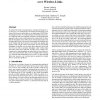Free Online Productivity Tools
i2Speak
i2Symbol
i2OCR
iTex2Img
iWeb2Print
iWeb2Shot
i2Type
iPdf2Split
iPdf2Merge
i2Bopomofo
i2Arabic
i2Style
i2Image
i2PDF
iLatex2Rtf
Sci2ools
MOBICOM
1999
ACM
1999
ACM
Optimizing the End-to-End Performance of Reliable Flows Over Wireless Links
We present the results of a performance evaluation of link layer error recovery over wireless links. Our analysis is based upon a case study of the circuit-switched data service implemented in GSM digital cellular networks. We collected a large set of block erasure traces in different radio environments and used a measurement-based approach to derive real-world models of the wireless link. We show that the throughput of the GSM circuit-switched data channel can be improved by up to 25 percent by increasing the (fixed) frame size of the reliable link layer protocol. Our results also suggest that adaptive frame length control could further increase the channel throughput. In general, our case study shows that pure end-to-end error recovery fails to optimize throughput when wireless links form parts of the end-to-end path. In many cases, it leads to decreased end-to-end throughput, an unfair load on a best-effort network, such as the Internet, and a waste of valuable radio resources (e.g...
| Added | 03 Aug 2010 |
| Updated | 03 Aug 2010 |
| Type | Conference |
| Year | 1999 |
| Where | MOBICOM |
| Authors | Reiner Ludwig, Almudena Konrad, Anthony D. Joseph |
Comments (0)

